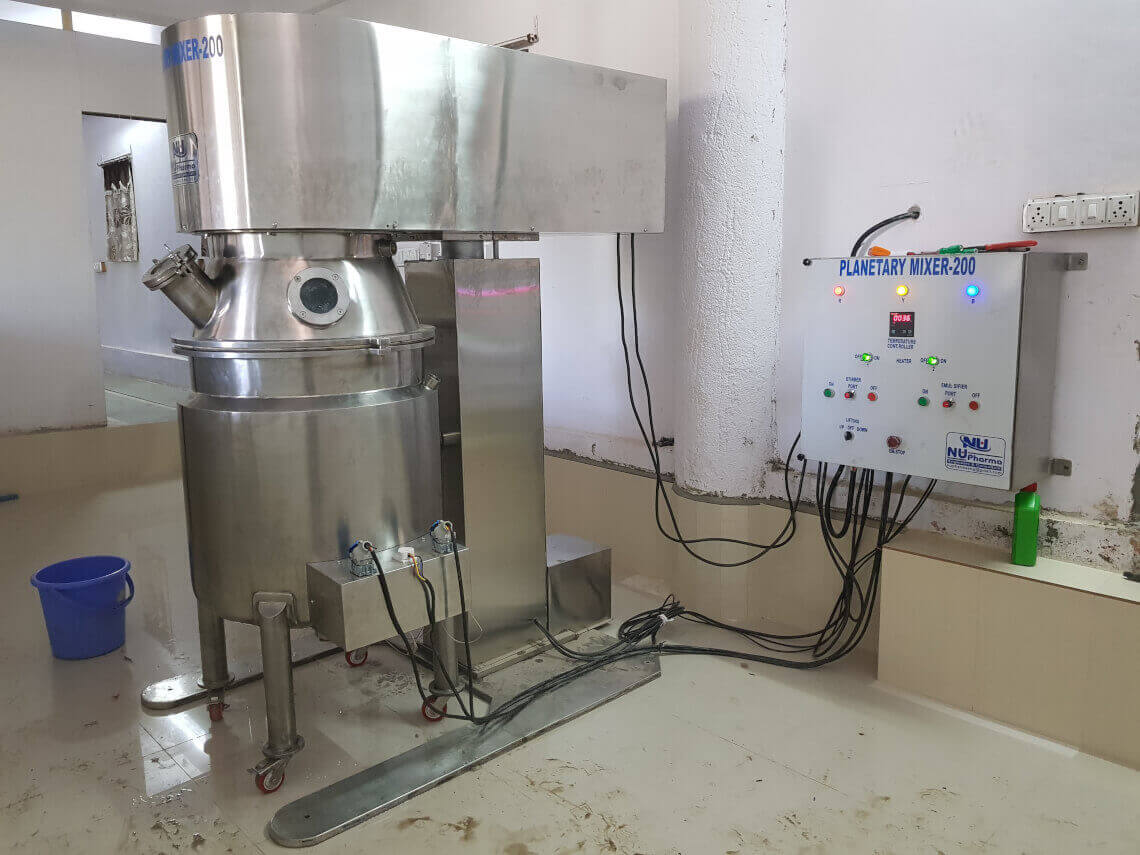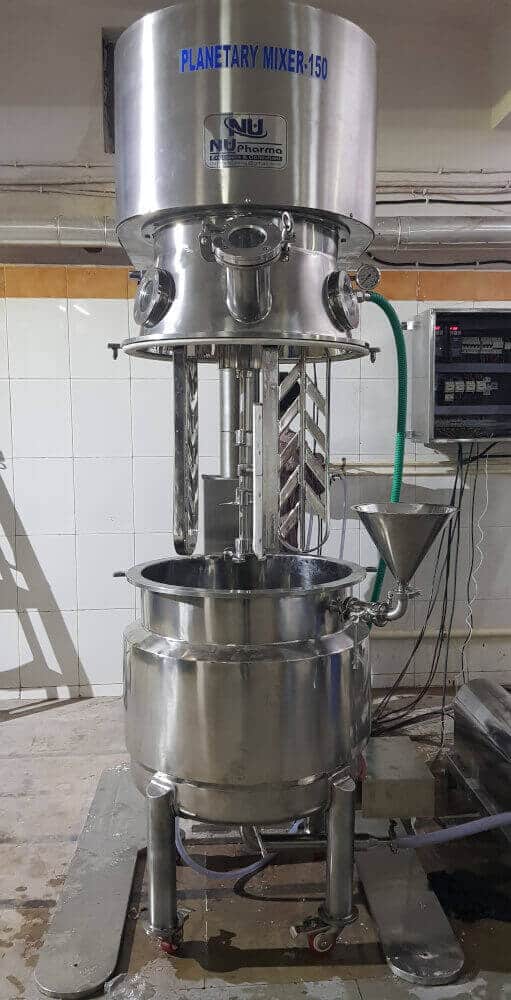
PLM Working Principle and Construction
Mixing is the soul of different manufacturing industries. It is difficult to estimate a product where manufacturing is not involved in any stage of the manufacturing process.
Definition of mixing
mixing is a process in which multiple components as a separate or roughly mixed state are treated as, that each particle is present nearest in possible position in attachment with a particle of each of the other ingredients.
shortly mixing is the randomization of dissimilar particles within a system.
What is Planetary Mixer?
The planetary mixer is mixing equipment used in the pharmaceutical industry which consists of a stationary bowl that is at the base and holds all the mixing ingredients and a set of beaters and mixers at the top which is rotated or agitated in a planetary motion to form a homogenous mixture.
the mixer blade which is dipped in the container containing the material. the chopper is also present in the container which has sharp edges or crushing blades. the crushing of the material is done by the sharp chopper or crushing blades. the process moves onward until and unless the mixing process is completed.
The planetary mixer is used mostly for wet mixing and to form a homogenous semisolid mixture of the ingredients. Liquid homogenous mixtures are also produced. The planetary motion of the beaters and the mixers create a homogenous mixture with minimum effort. This mixer is used when the material is in low quantity or the material is non-sticky.
Kinds of Industrial Planetary Mixer
- Single Blade Planetary Mixer
- Double Planetary Mixer
- Lab Planetary Mixer
Single Blade Planetary Mixer
Single-blade planetary mixer consists of a vessel that rotates in the motion of the planets as it travels around all parts of the vessel.
- It is perfect for lightly sticking heavy adhesive products.
- The rotation of the bat around its axis, the axis of the bowl near the walls, causes a mixture of homogeneous products.
- Batter ride makes cleaning easier.
- A scraper is present, and the function of which is to scrape the walls of the bowl as needed.
- A variety of batter shapes are suitable for product and processing applications. Look at the different types of blades available.
- Heavy, pistachio and dough-like masses were chosen for processing at low speeds.
Double Blade Planetary Mixer
It is also named a twin shaft mixer. Because the shaft rotates around a sun gear. The blades are simple rectangular ‘’gates” about 90 degrees apart. The blade paths meet and pass through the tank wall. Low-speed of the mixer and fast torque causes the mixing of sticky ingredient to form the homogeneous product.
- In the mixing process, two vertically mixed mixing tools rotate around a common sun gear. Also, they revolve rapidly around their axis on the principle of planet rotation.
- The swing-type scraper permanently sweeps inside the wall, carrying the material from the wall of the vessel to the mixing tools.
- The wane-shaped mixing tools overlap strong axial and radial motions in the mixed product.
- In a short time, the ingredients are well mixed, and even very difficult formulas can be found.
- A sharp vessel locking device connects the mixer vessel to the mixer. Because the vessel is fixed and has swivel wheels for easy transport.
- The standard version includes a dual mixing tools shaft powered by heavy-duty ball bearings.
Lab Planetary Mixer
Lab planetary mixer is essential for the process of high and medium viscosity, where ordinary solid dominant hard mixing vehicles have a small amount of high solid content. It is available in the range of 8 to 15-liter laboratory model. it is an option that a high scissor coils type disc can be fitted to sharpen the mixture, as well as double cooling and heating jackets, the possibility of vacuum operation, and different blade models, depending upon the product nature.
Parts of Planetary Mixer
The most common parts for any type of planetary mixers are
- Bowl
- Mixing Elements
- Lifting Mechanism
- Motor
- Control Panel
Bowl
The planetary mixer consists of a bowl. The bowl may be transported after working the process to different stations but during the process, it remains stationary. The bowl holds the ingredients that are to be mixed. The bowl has a jacket that can be used either for cooling or heating during the operation. The jacket is insulated on the outside to prevent heat transfer. The bowl has wheels for transportation. In some other types the bowl is fixed and the finished product is removed by a pumping mechanism.
Mixing Element
The top portion of the planetary mixer is the rotating component which has a homogenizer. The homogenizer is a set of beaters and a set of scrapers. The function of the beater is stirring the ingredients. The function of a homogenizer is the blending of the ingredients. The function of the scraper is to remove all the materials that are stick to the surface of the bowl. The top lid portion is also present and the homogenizer, beaters and scraper is present in the top lid.
Lifting Mechanism
A hydraulic lifting mechanism is used for the up and down motion of the top portion. In other types, the bowl and top portion are fixed and openings are provided for input of feed.
In this type, the ingredients are filled into the bowl manually so to provide adequate space the top portion is moved from the bowl.
Motor System
The hydraulic system has a motor that controls the operation and the hydraulic cylinder is supported by a vertical column. A charging hole is provided at the top lid for adding ingredients while the process is going on. A motor drives the homogenizer, beaters, and scraper which is controlled from the control panel.
The ingredients are added to the bowl and the top portion is moved downwards towards the bowl by the hydraulic mechanism. The lid is locked with the bowl and then the mixing process is started. There is a vacuum port available if the working procedure requires the process to be done under the vacuum zone. Similarly, the jacket can be used for heating or cooling based on the requirement of the working procedure.
The uniform mixture is obtained by the planetary motion of homogenizer, beaters, and scraper, and the process is ended after the desired mixture is achieved.
Control Panel
The planetary mixer is having a control panel screen. The screen has a different controlling system. The buttons control the speed of the motor. The speed of rotation is controlled. The bowl’s upward and downward moment is controlled by the control panel. All functions of the planetary mixer are controlled by the planetary mixer control panel.






